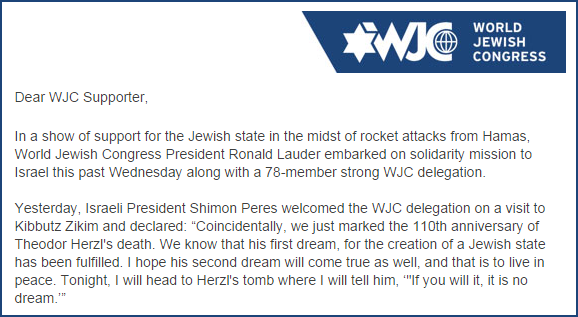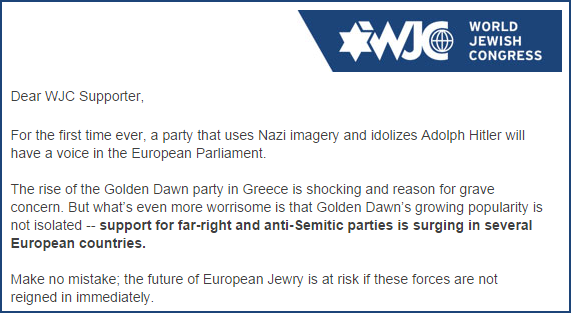by
Daniel Burstein, Director of Editorial Content
CHALLENGE
It happens every day — another traditional direct marketer begins a digital marketing campaign.
When it does happen, the marketers behind that campaign begin to notice that digital marketing offers new flexibility and timeliness that print deadlines and the speed of postal mail previously hampered.
However, that does not mean these marketing organizations can instantly engage in real-time marketing.
In fact, when I asked Cheryl Bailes, Director of Direct Mail Fundraising, World Jewish Congress (WJC) American Section, about this very topic, she responded, "I suppose we are not alone in the challenges for getting emails out the door. We too, at times, struggle with work load and approval time."
If you are working to include more news, trending topics and current events into your digital marketing and struggling with a slow process, you are not alone. Hopefully, this MarketingSherpa case study will help your transition.
We'll explore how Bailes was able to overcome these challenges and transform her organization, to the point where they now use news that happened just the day before in their email marketing campaign sends.
THE CUSTOMER
All marketing begins with the customer. For example, at WJC, the ideal customer is a person who wants to help protect and defend the rights and safety of Jews worldwide, combat anti-Semitism or help demand moral and material justice for Holocaust survivors.
That's because the World Jewish Congress is an international nonprofit organization with a mission to be "the diplomatic arm of the Jewish people."
The WJC American Section is the 501(c)3 not-for-profit arm of the larger organization, and it orchestrates all the fundraising to support the activities and programs of the WJC while encouraging American efforts to fight international anti-Semitism and promote tolerance.
"Although we do not have a traditional membership program, wherein we have various benefits depending on the level of giving, we do provide membership cards and call those who donate, either members or supporters (depending on the appeal). We receive support from donors all over the country and the globe, although most are from the USA," Bailes said.
CAMPAIGN
The WJC, like many nonprofits or traditional marketers, primarily relied on direct mail fundraising campaigns to reach donors. The team wanted to add an online channel to its marketing campaign as well.
Step #1. Launch a multichannel effort by combining email with direct mail
The WJC team began sending emails in the fall of 2013 to its online audience with just a handful of email appeals and a few online petitions.
It began an official online fundraising program in January 2014. The goal was to expand the fundraising program by opening up another line of communication as well as an alternate and faster way for donors to give.
"Our strategy as we began was to send emails that complement what we send out in the mail, for example, with our annual renewals, special appeals and year-end giving, similar messaging, general appeals for support. However, the content was not overly time-sensitive topics but focused on our mission, with occasional updates of events around the world," Bailes said.
This was the first transformation that Bailes drove in her organization, adding the online channel for what had been a traditional direct mail organization. That was only the beginning.
Step #2. Test real-time messages
While Bailes did not begin by sending time-sensitive topics, she saw the opportunity and started to test that tactic in the email program.
"As we learned when testing emails with accompanying online petitions, when we sent an email with a purpose or particular topic in recent news that affected world Jewry, with a sense of urgency to act or respond, we saw much better results (donations)," Bailes said.
The team created a new type of email and branded it the Diplomatic Alert Email "to bring our donors the most current news and topics of concern to them, while increasing our revenue," she added.
The team was able to create a process so efficient that they could reference news that happened as recently as the day before.
For example, a
Diplomatic Alert email from July includes the line:
"Yesterday, Israeli President Shimon Peres welcomed the WJC delegation on a visit to Kibbutz Zikim … "

Click here to see the full version of this creative sample
Step #3. Streamline production and approval process
The WJC's approval process for general email marketing was between two-and-a-half to three weeks long. To become an organization that leveraged real-time marketing, Bailes knew she would have to drive a second transformation — this one process-oriented.
Traditionally, Bailes said, "We ask our direct marketing agency, that writes our content for us, to provide us with drafts about a month in advance of the send date so there is enough time to edit and route for approvals."
However, for the real-time emails based on current news articles and events, the team was able get approval in 24 to 48 hours.
To achieve the quick turnaround, Bailes bypassed the traditional approval process by:
- Using content that is pre-approved (for example, from a press release)
- Sending out the emails without a personal signer (the emails are simply signed "World Jewish Congress" instead of being signed by WJC President Ronald S. Lauder like the general offers had been)
- Choosing real-time topics wisely
Regarding the last bullet point, because Bailes knew that the real-time approval process was truncated and didn't include as many people as the traditional approval process, she was careful about which topics she chose.
"Some topics can be rather controversial, and since the ability to do our important work relies heavily on the relationships we've established with various communities and political leaders around the world, we do need to be careful," she said. "We try to choose topics that won't jeopardize what we've worked so hard to establish. If something is going to compromise WJC's relationships or our reputation, we tend to avoid it."
Step #4. Add current events to general offers
From the success of the timely emails, the team saw value in branching out and also adding current events in to their general offers, resulting in a transformation in the way they wrote the general offers.
"In addition to the Diplomatic Alerts, with our monthly e-mail appeals and renewal, we try to include content and topics, that, although more general, include more examples of relevant and current events to support our need for funding," Bailes said.
While these emails focus around planned messaging as opposed to responding to real-time issues as they occurred, the team did add in an element of current events on a larger time scale.
For example, one of the
emails from the July Appeal mentioned:
"And this past month, an unabashed…"

Click here to see the full version of this creative sample
Segmentation
Another element of appealing to real-time events, although not often thought of this way, is to segment email message based on the events (actions) of a person's life.
For example, WJC segments its list based on the donor's previous record of giving.
"If a donor has already renewed their annual support or membership, we will send the appeal series messaging (No Membership Renewal Ask). But if a supporter has not yet renewed, we will send the email series (similar content to the appeal). However, it will have a renewal ask instead of a general ask, requesting for donors to renew their support," Bailes explained.
RESULTS
At its core, this campaign did what all good marketing should — met the organization's goals in a way that better serves customers' needs.
For WJC, those customers are donors and that need was a desire for a real-time understanding of the effect of global events. "When certain communities are affected and at risk, such as what we saw this past year in Israel … we reported on that to our donors, and they [those emails] were most successful," Bailes said.
Not only did the campaign offer that information to donors, but it also boosted the organization's bottom line.
In comparison to the regularly planned appeal and renewal messages, the supplementary messaging had:
- An 11% boost in open rates
- A 22% lift in revenue
- A 33% increase in average gift
- A 134% jump in page completion rates
However, there was a 55% decrease in clickthrough rates and an 8% decrease in the actual number of gifts. Also, those who initially respond to the news do tend to only donate to news-related messaging.
"What seems to work best for us is staying relevant … when there is a sense of urgency or need to take immediate action from what is going on in the news that will have an impact on our audience — a call to action to supporters seems to be quite successful. Much more so than overall general appeals that are less topical or urgent," Bailes concluded.
This case study has been selected as one of five finalists for the MarketingSherpa Award — Reader's Choice Email Campaign. Keep reading MarketingSherpa newsletters to see case studies from other finalists, and then in a few weeks, we'll ask you to vote for your favorite on the MarketingSherpa blog.Creative Samples
- Real-time email #1
- Real-time email #2
- Real-time email #3
- Regular campaign email #1
- Regular campaign email #2
- Regular campaign email #3
Sources
World Jewish CongressChapman Cubine Adams + HusseyRelated Resources
MarketingSherpa Email Summit 2015 — February 23-26, 2015 at the ARIA Resort & Casino Las Vegas
Launch and Learn: How marketers can keep up in a real-time worldReal-time Marketing: Don't complain about the weather, put it to workReal-time Marketing: Crowdsourced video of keynote from MarketingSherpa Email SummitSegmentation: How a small office supply ecommerce site boosted revenue 25% by sending more emails











